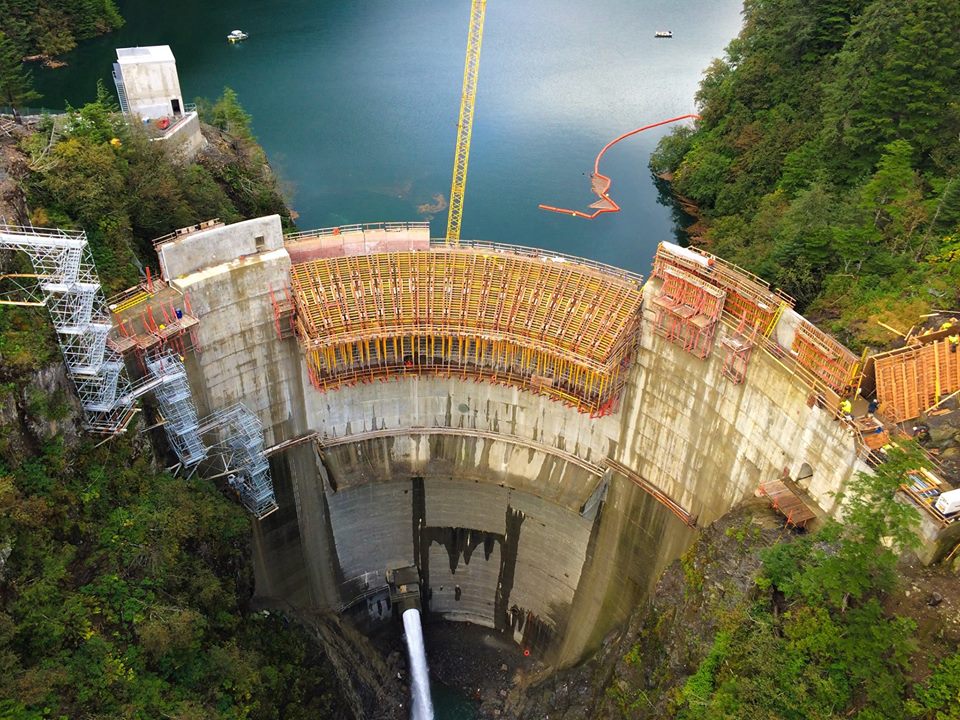
“One of the dangers there, as oil prices continue to go up, is that people will start to shift over to electricity, and all that additional capacity that you’ve gained by raising the dam will just go into existing inefficient buildings, or into new inefficient buildings,” says Jon Heller. (Blue Lake Expansion photo/Desiree Brandis)
Sitka’s public library and centennial building will both be undergoing major renovations over the next couple of years, each growing in size by roughly one-half. But the energy costs to run both buildings will stay the same, thanks to a suite of new technologies that keep heat indoors.
The consultant who’s designing the systems says engineers now consider conservation to be a major energy resource in new construction.
Energy conservation has been around for a long time. Everyone who’s bought weather stripping, or a timer for a bathroom fan, or a compact fluorescent bulb is on board with energy conservation.
But conservation is getting real traction in the world of building design.
“The biggest, best source of new capacity that we have is looking at energy conservation as a resource.”
Jonathan Heller is a mechanical engineer with Ecotope in Seattle.
“The energy that’s being used in existing buildings can be harvested through energy conservation in those buildings to supply new buildings, instead of building a new power plant.”
That seems like a dramatic claim, but the numbers, at least, bear him out. Heller has designed systems for Sitka’s Kettleson Library and Harrigan Centennial Hall that create efficiency on a scale that until recently didn’t really seem possible.
“Both of those buildings are getting about 50-percent bigger in the renovations. By using improved insulation, improved lighting technology, new generation heat pump technology, and heat-recovery ventilation, those buildings will use about one-third the energy use per square foot as they did before. That allows us to completely eliminate the use of fuel oil, shifting completely on to electricity, but without increasing the amount of electricity that the building uses overall.”
Harrigan Centennial Hall burns about $26,000 in fuel oil annually, and the library is not far behind. The city won a $239,000 grant to install heat pumps in Harrigan, but project manager Kelli Cropper says the cost is not significantly more than installing conventional heating systems.
Sitka has a lot of clean hydropower, with more on the way as construction winds down on a $157-million project to raise Blue Lake Dam.
Part of the efficiency formula is to capture as much as this energy as possible.
“One of the dangers there, as oil prices continue to go up, is that people will start to shift over to electricity, and all that additional capacity that you’ve gained by raising the dam will just go into existing inefficient buildings, or into new inefficient buildings.”
Heller’s strategy conserves heat by keeping it inside the building. It’s a long way from just improving insulation, and points to systems that are becoming more common in climates like Southeast Alaska’s.
“Commercial buildings with a lot of people in them need a lot of fresh air. The traditional way to do that is to bring in a lot of fresh air from the outside, heat it up with your fuel oil boiler, and supply it into the building, at the same time exhausting the stale air out of the building and throwing it away. A heat-recovery ventilator takes the warm exhaust air and puts it over the heat exchanger, with the fresh air coming in, so that the fresh air picks up the heat, before it comes into the building. So that you don’t need to provide additional heat for that ventilation air.”
And Heller has a few other tricks up his sleeve. The heat pumps — like those installed in Blatchley Middle School and Pacific High — are supported by internal heat exchangers. When one side of the building warms up, heat can be drawn from that side and redirected to the cooler side. And the latest generation of air-source heat pumps work well at far lower temperatures — to below zero.
Heller is part engineer, part evangelist talking about this stuff. In his home state of Washington, there’s an ambitious plan to have government buildings using 70-percent less energy by 2030. The savings — in Washington or in Sitka — could be redistributed.
“If we start to look at energy conservation as a resource, as a way to increase our capacity to provide power to people, we can make a shift off of fossil fuels onto electricity, and at the same time allow for more industry to come into the community – have the ability to grow, essentially.”
Heller calls conservation the cheapest form of energy, and what money is spent on it is invested locally in construction and improving buildings rather than just “burning it up.”
KCAW’s Melissa Marconi-Wentzel contributed to this story.































